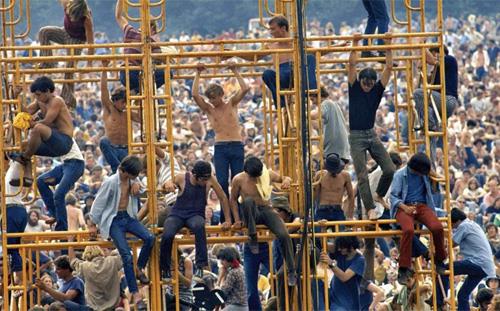
The 1969 Woodstock festival was not the most significant flashpoint of the 1960s counterculture, but it has always been the most over-romanticized.
The mythologizing continues in Woodstock: Three Days That Defined a Generation, a 50thanniversary film that airs Tuesday at 9 p.m. ET on PBS’s American Experienceseries.
Filmmaker Barak Goodman aims to shift the focus of this Woodstock documentary from the music to the crowd and some of the peripheral characters like members of the Hog Farm, a collective that spent much of the weekend preparing and distributing free food.
While Goodman’s film thus differs considerably from the music-focused 1970 film Woodstock, it doesn’t break much new ground. Much of the extensive writing about Woodstock over the years has rhapsodized primarily about the sense of audience community, arguing that Woodstock proved the often-mocked “peace and love” ethic of the 1960s counterculture really could work.
Goodman echoes this sentiment, with video footage of happy fans grooving to the music and skinny-dipping in the pond and covering up on Sunday afternoon when the big downpour blew in.
His film, like most Woodstock remembrances, assumes that most people who would watch this film know the basics.
Woodstock, the festival, was a three-day music event held Aug. 15-17, 1969, on Max Yasgur’s farm in Bethel, N.Y. It featured dozens of folk and rock artists, including some but not all of the day’s biggest. The Who, Creedence Clearwater Revival, Santana, the Band, Sly Stone, Janis Joplin, and Jimi Hendrix were there. Bob Dylan and the Rolling Stones were not.
The organizers optimistically expected 150,000 people. The actual crowd topped 400,000, so many that they overran the gates and fences and turned the whole thing into a free festival. It rained Friday and Sunday, as it almost always will do in the Catskills in August, and by the time Hendrix wound it up by the dawn’s early light Monday, Max’s farm was a landfill of soggy, abandoned sleeping bags, tents, cardboard boxes, foodstuffs and pretty much everything else that 400,000 people would generate over that period of time.
Before the crowd had even gotten home and taken showers, Woodstock had become a cultural icon. And a myth.
Goodman argues, correctly, that hundreds of thousands of people had a good time. There was minimal conflict and a relatively modest medical tally: two people died, one from an overdose and another in an accident, and the dozens who were hospitalized all recovered.
Considering the size of the crowd, that’s remarkable. It’s not sketchy for anyone who attended Woodstock to remember it as a pretty cool and unique weekend.
It’s more of a stretch to call it “three days that defined a generation.”
As integral as music was to the culture of the 1960s, Woodstock neither created nor added to that legacy. The Beatles, Motown, Dylan, Aretha, Hendrix, Dusty Springfield, Mississippi John Hurt, Frank Zappa, artists like that, they built the music.
Woodstock showcased some of that music, at a level that wasn’t much above average. There’s a reason most historians cite exactly one musical moment from Woodstock: Hendrix’s closing “Star-Spangled Banner,” which 90 percent of the crowd missed because they had already left. Much of the rest of the music was okay. “Defining,” no.
As for the other part, what Goodman seeks to define as the ultimately coming-together of all the admirable forces at work through the 1960s, let’s take a step back and see Woodstock for what it really was.
It was a party.
It was three days of free music, often supplemented by free food, in a pleasant place where there were no parents, no cops, pretty much no rules and no obligations. Go naked, smoke dope? Right on.
The real legacy of any generation, including that of the 1960s and the counterculture, doesn’t lie in the parts that were easy. It lies in the parts that were hard, often complex and almost never neatly resolved.
Goodman has no obligation to address that. He’s simply revisiting Woodstock, on perhaps the last major occasion when those who attended or hail from that generation can savor the memory.
But with the death of Woodstock 50 pretty much ensuring that the franchise is no longer a living entity, it’s worth having it on the record that listening to rock music for three days and letting someone else clean up after you isn’t a revolution. Or a legacy.
It’s a party.